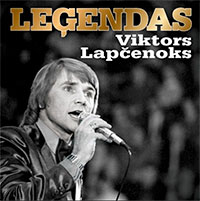Few voices in Latvian popular music are as recognizable as the voice of singer Viktors Lapčenoks. Throughout a decades-long career, many of the songs he has sung have become essential classics of the Latvian popular music repertoire. One could even say his voice was the defining voice of the 1970s in Latvia. To celebrate his many achievements, and to celebrate his 70th birthday in 2017, the record label MicRec released the latest entry in their Leģendas series with a collection of his best and most popular songs.
Lapčenoks’ powerful and distinctive voice are a major reason many of these songs remain popular even today, and it is not at all an exaggeration when music critic Daiga Mazvērsīte, in her liner notes to this collection, compares him to world famous rock singers like Robert Plant and David Coverdale. His crisp and clear delivery can be heard in songs like the all-time classics like ‘Zied ievas Siguldā’, ‘Kurzeme’, and ‘Inese’.
Though Lapčenoks worked with many composers, his primary compositional collaborator is Latvian popular music composer Raimonds Pauls. Their work together began in 1971, and, together, they produced an amazing collection of popular music songs.
Besides Lapčenoks’ collaboration with Pauls, the other artist that he frequently collaborated with was singer Nora Bumbiere, and this collection has six of their duets, including such popular songs as ‘Grieze’ and ‘Undīne’. One can see why they were a particularly popular duo, as their voices mesh together effortlessly, with their natural and professional sound.
Though many of the songs he performed were serious and dramatic, there are still moments of humor, for example on the swaggering rock ditty ‘Vardīte’, which, though sung from the point of view of a frog, is still one of the album’s highlights. One could say the same for the song ‘Ai-dundur-dundur-dun-dun-dun’, an otherwise silly song that is made memorable by Lapčenoks and Bumbiere.
Though many of the songs Lapčenoks recorded were popular songs, this collection does contain a few songs that are a bit more ambitious in scope, perhaps even progressive – for example, the expansive ‘Čakarnītis’, which is raised by Lapčenoks’ soaring, expressive vocals. The same could be said for ‘Manai dzimtenei’, which, though it became even more popular as a Song Festival song, Lapčenoks’ deeply emotional delivery revealed the strength and beauty of this song, and allowed it to grow into one of Pauls’ most popular songs of all time.
Of course, at times the powerful performances can become slightly overwrought, for example in the song ‘Varbūt’, a sentimental song about what might have been, but might have benefited from a more nuanced, subtle approach.
Distilling multiple decades and hundreds of songs onto a single CD is simply not possible, so there were quite a few tracks left out. One does wish that they included tracks with music by other composers that Lapčenoks has worked with throughout the years (all tracks on the album were composed by Raimonds Pauls). This is also not the first ‘best of’ release for Lapčenoks, as there have been multiple throughout the years, so long time fans may already have most of these songs on CD already, so perhaps it could have included a few more rarities and less frequently heard songs. However, as introductions to the artist, this is still an excellent, comprehensive collection.
Viktors Lapčenoks could very well be considered the voice of the 1970s in popular music in Latvia. Many of the songs he recorded remain immensely popular today. This Leģendas release, containing many of those songs, will reaffirm Lapčenoks as one of the greatest popular music singers in Latvian history, and serves as a fitting tribute to this monumental singer and his voice.
For further information, please visit the Viktors Lapčenoks website.
Leģendas
Viktors Lapčenoks
MicRec, MRCD 564, 2017
Track listing:
- Dziesmiņa par prieku
- Zilā
- Nekal mani gredzenā
- Kurzeme
- Inese
- Lana
- Varbūt
- Zied ievas Siguldā
- Sanāciet, sadziediet, sasadancojiet
- Kad saule aiziet
- Vardīte
- Čakārnītis
- Grieze
- Rudacīte
- Ai-dundur-dundur-dun-dun-dun
- Undīne
- Manai Dzimtenei
- Latviešu jūrniekiem
- Lapsenes nāve
- Tā diena





